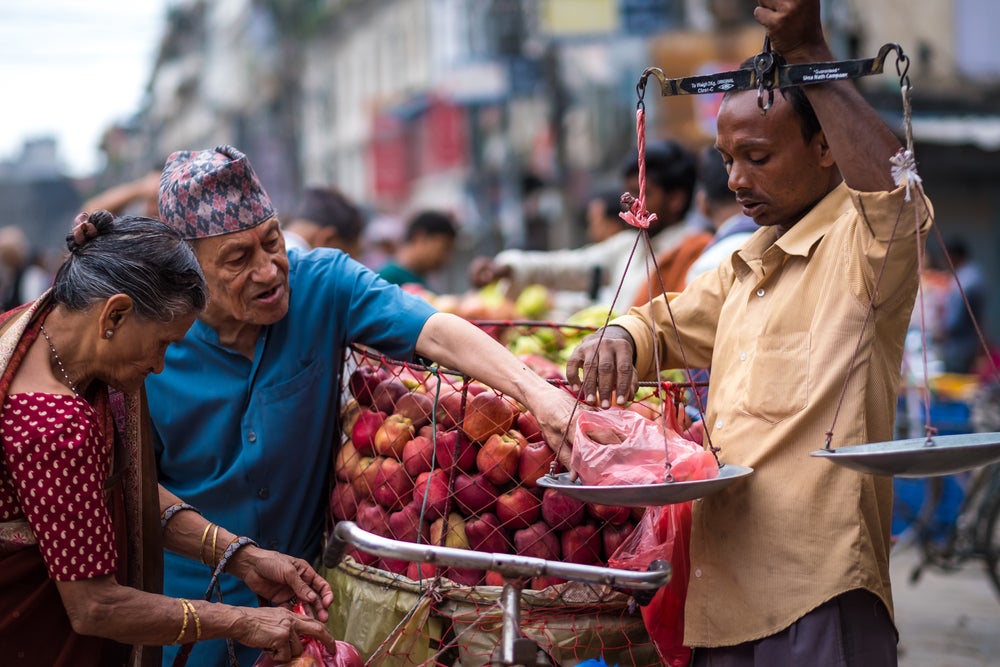 Nepalese man weighs up apples for older people on the local street market in Kathmandu, Nepal. Photo: Shutterstock
Nepalese man weighs up apples for older people on the local street market in Kathmandu, Nepal. Photo: Shutterstock
Last month, India reelected Narendra Modi to serve a second term as prime minister. General elections were also held in neighboring Pakistan and Bangladesh last year. These new administrations have a rare opportunity to collectively work on issues that affect the entire region.
Among them is the very inadequate level of economic engagement within a region that is the world’s fastest growing. As our recent report, A Glass Half Full: The Promise of Regional Trade in South Asia shows, South Asian countries’ trade regimes actively discriminate against each other, thus denying their citizens the benefits of vibrant trade.
Intraregional trade could increase almost threefold, from $23 billion to $67 billion – and even this is an underestimate.
To realize this potential, there are several concrete steps South Asian countries can take.
Let SAFTA serve its purpose
The South Asian Free Trade Agreement (SAFTA) was established in 2006 but to little success. One of the reasons behind SAFTA’s ineffectiveness is the so-called “sensitive list”- a long list of products that are exempt from the tariff liberalization program.
Many countries have long sensitive lists, over 44 percent of the value of imports in Bangladesh and Sri Lanka, and 36 percent in Nepal, and 35 percent on average for the region. These lists undermine the purpose of a free trade agreement.
SAFTA can only work if South Asian countries agree on a schedule to eliminate sensitive lists.
To achieve that with minimal disruption, the tariff reduction should be transparent and gradual for sectors where employment is high.
Eventually, the lists should contain very few products to be protected, as has been done in the Association of Southeast Asian Nations (ASEAN) Free Trade Agreement.
Furthermore, SAFTA members should gradually eliminate para-tariffs that are protective and non-transparent duties on imports and non-domestic products , and contribute to the overall anti-export bias of many trade regimes in South Asia.
These para-tariffs are currently not included in free trade negotiations.
Tackle non-tariff barriers too
Several other factors obstruct free trade in South Asia. Some of these are real barriers while others are perceived. The latter arise due to a lack of information on regulations and standards and inadequate infrastructure for measuring and certifying quality.
South Asian countries could consider establishing a regional institution which can provide traders with the information they need to address their issues or direct complaints to relevant authorities within countries.
Campaigns and workshops can also be initiated.
For instance, spreading awareness about the need for and procedures relating to pest risk analysis on agricultural products in different countries would facilitate the movement of such products across borders. This institution can start work even on a bilateral basis, and then expand to include other countries, based on demand.
Improve intraregional connectivity
A lack of adequate transportation between South Asian countries makes moving goods and services across borders costly. For example, high-value trade often depends on air travel, but regional air connectivity is restricted in South Asia and poor even between capitals.
Today there are 147 flights per week between Colombo and at least 12 Indian cities - significantly higher than any pair of South Asian countries.
This liberalization occurred without an open skies agreement. Rather, India and Sri Lanka pursued an incremental approach which was accompanied by supporting reforms such as Sri Lanka providing visa-on-arrival for Indian travelers and the implementation of the India-Sri Lanka Free Trade Agreement in 2000 .
Reduce the trust deficit
Healthy trade relations around the world are grounded in mutual trust. In South Asia, however, a conflict-ridden history has eroded trust between countries. This has given rise to negative stereotypes which are exacerbated by a lack of people-to-people contact. Initiatives that reduce this trust deficit should be promoted across the region.
An example that could be replicated by other South Asian countries is the border haats between India and Bangladesh. These haats allow small-volume trade in weekly markets amongst the two countries’ border communities. Not only have participating vendors reported an increase in income and a decline in informal trade. Contact and exposure have also led to positive views of each other.
Haats could be scaled up and replicated at other land borders in the region- perhaps at the India-Pakistan or Pakistan-Afghanistan borders where illegal trade is rampant and trust short in supply.
Another promising initiative is the South Asia Economic Students’ Meet, which has brought together students from colleges and universities across the region for the past 15 years. The annual conference allows these young leaders to engage on development issues and form friendships they cherish.
Let trade lead the way
Trade can help catalyze relations between countries. Trade helps build trust which in turn leads to more trade . South Asian countries, therefore, need not wait for relations to improve before they can increase trade with each other.
Rather, trade can help pave the path for more prosperity and perhaps better relations.


Join the Conversation